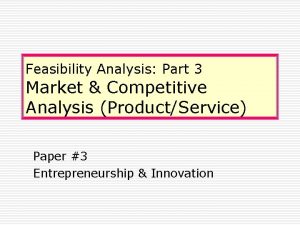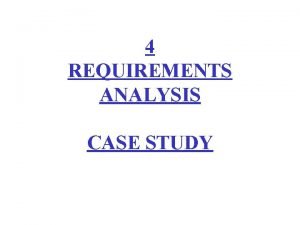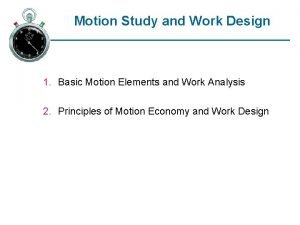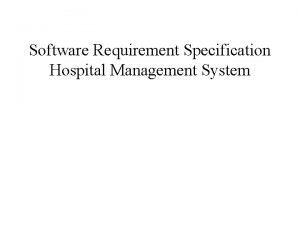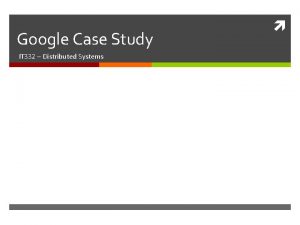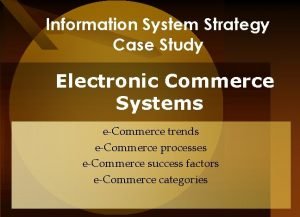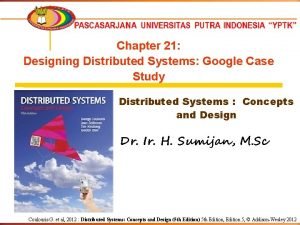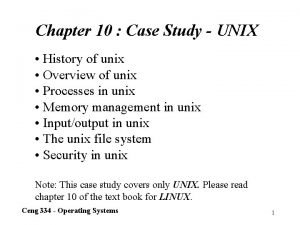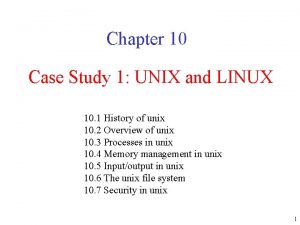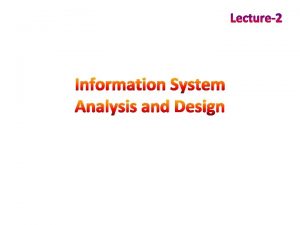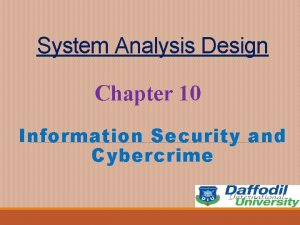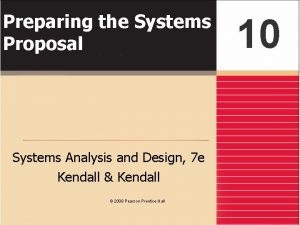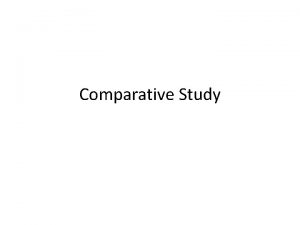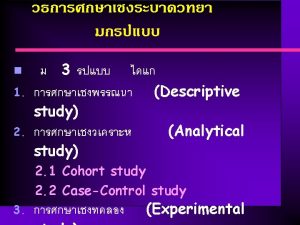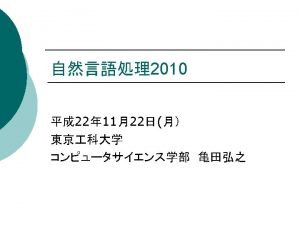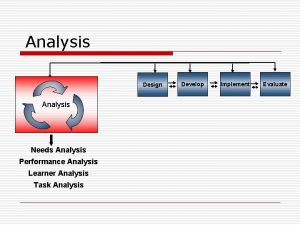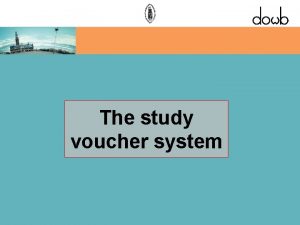System Analysis What Is System Analysis A study





































- Slides: 37

System Analysis

What Is System Analysis ? • A study of a system and its components for the purposes of studying how well those components parts works and interacted to accomplish their purpose

System Analysis Approaches • Model Driven Analysis : – Stuctured analysis – Object oriented analysis • Accelerated System Analysis – Discovery prototyping – Rapid Architected Analysis

Model-Driven Analysis Methods Model-driven analysis – a problem-solving approach that emphasizes the drawing of pictorial system models to document and validate both existing and/or proposed systems. Ultimately, the system model becomes the blueprint for designing and constructing an improved system. Model – a representation of either reality or vision. Since “a picture is worth a thousand words, ” most models use pictures to represent the reality or vision. 5 -4

Model-Driven Methods Structured analysis – a model-driven, process-centered technique used to either analyze an existing system, define business requirements for a new system, or both. The models are pictures that illustrate the system’s component pieces: processes and their associated inputs, outputs, and files. Information engineering (IE) – a model-driven and data-centered, but process-sensitive technique for planning, analyzing, and designing information systems. IE models are pictures that illustrate and synchronize the system’s data and processes. Object-oriented analysis (OOA) – a model-driven technique that integrates data and process concerns into constructs called objects. OOA models are pictures that illustrate the system’s objects from various perspectives such as structure and behavior, and interactions of the objects. Object – the encapsulation of the data (called properties) that describes a discrete person, object, place, event, or thing, with all the processes (called methods) that are allowed to use or update the data and properties. The only way to access or update the object’s data is to use the object’s predefined processes. 5 -5

A Simple Process Model 5 -6

A Simple Data Model 5 -7

A Simple Object Model 5 -8

Accelerated Systems Analysis Accelerated systems analysis approaches emphasize the construction of prototypes to more rapidly identify business and user requirements for a new system. prototype – a small-scale, incomplete, but working sample of a desired system. • Accelerated systems analysis approaches – Discovery Prototyping – Rapid Architected Analysis 5 -9

Discovery Prototyping Discovery prototyping – a technique used to identify the users’ business requirements by having them react to a quick-and-dirty implementation of those requirements. – Advantages • Prototypes cater to the “I’ll know what I want when I see it” way of thinking that is characteristic of many users and managers. – Disadvantages • Can become preoccupied with final “look and feel” prematurely • Can encourage a premature focus on, and commitment to, design • Users can be misled to believe that the completed system can be built rapidly using prototyping tools 5 -10

Rapid Architected Analysis Rapid architected analysis – an approach that attempts to derive system models (as described earlier in this section) from existing systems or discovery prototypes. • Reverse engineering – the use of technology that reads the program code for an existing database, application program, and/or user interface and automatically generates the equivalent system model. 5 -11

Context of Systems Analysis 5 -12

Systems Analysis Phases • Problem Analysis Phase – Is a new system worth building? • Requirements Analysis Phase – What do the users need and want from the new system? • Logical Design Phase – What must the new system do? • Decision Analysis Phase – What is the best solution? 5 -13

Initial Phase - Scope Definition • Also known as preliminary investigation phase, initial study phase, survey phase, planning phase • Purpose : – Answer the question : “Is this problem worth looking at ? ” – Establish the size and boundaries, vision, project’s limitation, participants, schedulle and budget • Stakeholder included : system owner, project manager and system analyst

• Deliverables : – Statement of Work (So. W) : contract with management and the user communiaty to develop or enhance an IS, defines vision, scope, constrain, high level user requirement, schedule and budget – Synonyms include project charter, project plan, SLA

Scope Definition Task • • • Identify baseline problems and opportunities Negotiate baseline scope Assess baseline project wothiness Develop baseline schedule and budget Communicate project plan

Task 1. 1 Identify Baseline Problems • Lead by senior analyst and project manager • Output : preliminary problem statement, identify detail of problem in term of : – Urgency – Visibility – Benefit – Priority – Possible solution

Task 1. 2 Negotiate Baseline Scope • Scope : aspects of busines that will and will not be included in the project • Scope can be define in term of : – What type of data describe the system – What business process included – How system interact with user/other system • Deliverables : problem statement with scope

Task 1. 3 Assess Baseline Project Worthiness • Lead by system analyst and PM, and system owner make decision • Focus on : “will the solving problems return enough value to offset the cost that will incur to develop the system ? • No physical deliverables, other that go or no go decision. • Decision can be : cancelled, scope revised, or approved

Task 1. 4 Develop Baseline Schedule and Budget • • Done if the project was approved Input : problem statement with scope Lead by Project Management Output : Statement of Work

Task 1. 5 Communicate The Project Plan • Formally launch the project, communicate the project goal and schedule to entire of business community • Known as project kick off

Tasks for Problem Analysis Phase Systems Analysis 5 -22

Task of Problem Analysis Phase 2. 1 2. 2 2. 3 2. 4 2. 5 Understand problem domain Analyze problem and opprtunities Analyze busines process Establiesh system improvement objective Update or Refine the Project Plan

Cause-and-Effect Analysis Cause-and-effect analysis – a technique in which problems are studied to determine their causes and effects. In practice, effects can be symptomatic of more deeply rooted or basic problems which, in turn, must be analyzed for causes and effects until such a time as the causes and effects do not yield symptoms of other problems. 5 -24

System Improvement Objectives Objective – a measure of success. It is something that you expect to achieve, if given sufficient resources. • Reduce the number of uncollectible customer accounts by 50 percent within the next year. • Increase by 25 percent the number of loan applications that can be processed during an eight-hour shift. • Decrease by 50 percent the time required to reschedule a production lot when a workstation malfunctions. Constraint – something that will limit your flexibility in defining a solution to your objectives. Essentially, constraints cannot be changed. • • 5 -25 The new system must be operational by April 15. The new system cannot cost more than $350, 000. The new system must be web-enabled. The new system must bill customers every 15 days.

5 -26

Outline for System Improvement Report 5 -27

Tasks for Requirements Analysis Phase 5 -28

Functional vs. Nonfunctional Requirements Functional requirement – a description of activities and services a system must provide. • inputs, outputs, processes, stored data Nonfunctional requirement – a description of other features, characteristics, and constraints that define a satisfactory system. • Performance, ease of learning and use, budgets, deadlines, documentation, security, internal auditing controls 5 -29

Expressing System Requirements • Draft Functional and Nonfunctional Requirements – Could use simple list of system improvement objectives – Increasingly systems analysts express functional requirements using Use Cases Use case – a business scenario or event for which the system must provide a defined response. Use cases evolved out of object-oriented analysis; however, their use has become common in many other methodologies for systems analysis and design. 5 -30

• Prioritize System Requirements Prioritization of requirements can be facilitated using timeboxing. Timeboxing – a technique that delivers information systems functionality and requirements through versioning. 1. The development team selects the smallest subset of the system that, if fully implemented, will return immediate value to the systems owners and users. 2. That subset is developed, ideally with a time frame of six to nine months or less. 3. Subsequently, value-added versions of the system are developed in similar time frames. – A mandatory requirement is one that must be fulfilled by the minimal system, version 1. 0 – A desirable requirement is one that is not absolutely essential to version 1. 0. It may be essential to the vision of a future version. 5 -31

Tasks for Decision Analysis Phase of Systems Analysis 5 -32

Feasibility • Technical feasibility – Is the solution technically practical? Does our staff have the technical expertise to design and build this solution? • Operational feasibility – Will the solution fulfill the users’ requirements? To what degree? How will the solution change the users’ work environment? How do users feel about such a solution? • Economic feasibility – Is the solution cost-effective? • Schedule feasibility – Can the solution be designed and implemented within an acceptable time period? 5 -33

Candidate Systems Matrix 5 -34 (Continued)

Candidate Systems Matrix (concluded) 5 -35

Feasibility Matrix 5 -36

Outline for a Typical System Proposal I. Introduction A. Purpose of the report B. Background of the project leading to this report C. Scope of the report D. Structure of the report II. Tools and techniques used A. Solution generated B. Feasibility analysis (cost-benefit) III. Information systems requirements IV. Alternative solutions and feasibility analysis V. Recommendations VI. Appendices 5 -37
 What is case series
What is case series Retrospective cohort study
Retrospective cohort study Work study and method study
Work study and method study Study less study smart
Study less study smart Phytogeographical regions
Phytogeographical regions Time study objectives
Time study objectives Distinguish between time study and motion study
Distinguish between time study and motion study Feasibility matrix example
Feasibility matrix example Spend analysis case study
Spend analysis case study Industry market feasibility analysis
Industry market feasibility analysis Vodafone case study analysis
Vodafone case study analysis Business analyst project case study
Business analyst project case study Competition analysis in feasibility study example
Competition analysis in feasibility study example Portfolio analysis case study
Portfolio analysis case study Diagram studied in requirement analysis
Diagram studied in requirement analysis Effective therbligs
Effective therbligs Sheryl kantrowitz
Sheryl kantrowitz Structured analysis approach
Structured analysis approach Types of fact gathering in system analysis and design
Types of fact gathering in system analysis and design Activity diagram for hospital management system
Activity diagram for hospital management system Google distributed system case study
Google distributed system case study Chapter 35 section 1 the digestive system
Chapter 35 section 1 the digestive system Management information system case study
Management information system case study Laudon and laudon 2012
Laudon and laudon 2012 Business information value chain
Business information value chain Sdlc analysis phase
Sdlc analysis phase Restaurant feasibility study
Restaurant feasibility study Cylinder measurement
Cylinder measurement Information system in e commerce case study
Information system in e commerce case study Earth moon
Earth moon Facebook distributed system case study
Facebook distributed system case study Google distributed system case study
Google distributed system case study Case study of unix operating system
Case study of unix operating system Management information system case study banking
Management information system case study banking Case study of unix operating system
Case study of unix operating system Characteristics of system
Characteristics of system System security in system analysis and design
System security in system analysis and design An effective systems proposal report should
An effective systems proposal report should












